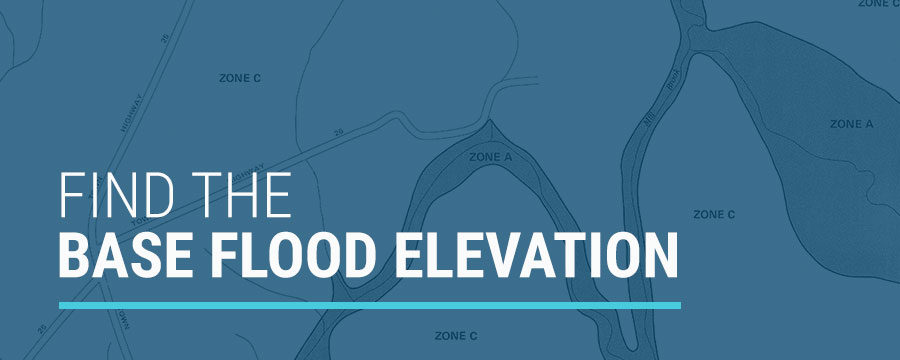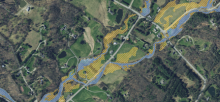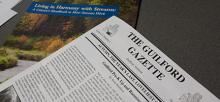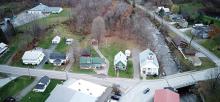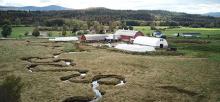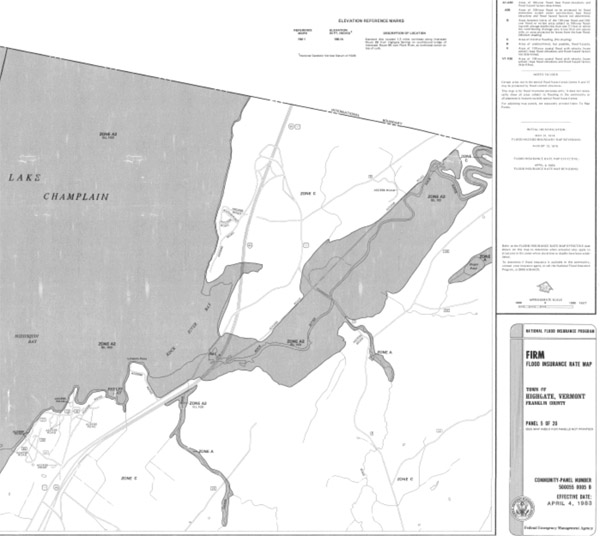 Getting comfortable with using floodplain maps is an important part of participating in the National Flood Insurance Program (NFIP) and allowing residents in your community to purchase flood insurance. Maps can help you identify where it isn’t safe to build or where buildings need to be floodproofed. For instance, if a resident wants to build an accessory structure, you’ll need to use maps to help identify if it’s in a River Corridor (RC) and/or a Special Flood Hazard Area (SFHA) and how those designations influence the project.
Getting comfortable with using floodplain maps is an important part of participating in the National Flood Insurance Program (NFIP) and allowing residents in your community to purchase flood insurance. Maps can help you identify where it isn’t safe to build or where buildings need to be floodproofed. For instance, if a resident wants to build an accessory structure, you’ll need to use maps to help identify if it’s in a River Corridor (RC) and/or a Special Flood Hazard Area (SFHA) and how those designations influence the project.
Most floodplain maps were originally developed as part of the NFIP. There may be areas designated as floodplains that actually are at a much lower risk of flooding and may justify amending the maps with a Letter of Map Amendment (LOMA) through FEMA. Contact the FEMA Map Specialists for more information. And there may be areas that are indicated to be outside of the floodplain but actually could still flood. This certainly happened during Tropical Storm Irene. While not perfect, they’re still a solid guide for what areas are at risk of flooding and towns and cities need to use them to regulate building within the SFHA and the RC if a River Corridor bylaw has been adopted.
All RCs are mapped on the Flood Ready Atlas. Smaller streams with a watershed more than a half square mile will appear as yellow lines, for which the RC is officially fifty feet from the top of the stream bank. Learn more about River Corridors, how communities are reducing risk by protecting them, and how you might evaluate an application to build an accessory structure near one.
The mapping of SFHA is available on the same Atlas for about half of Vermont. NFIP paper maps were developed in the 1970’s to show SFHAs. FEMA has since created digital versions of some of these maps, including SFHAs for Bennington, Chittenden, Rutland, Washington, Windham and Windsor Counties and the communities of Bradford Village, Hardwick, Jay, Montgomery, Newbury, Stowe, and Wolcott. SFHAs will show up on the Flood Ready Atlas in these counties/communities.
What If Your Community Isn’t Digitized?
You’ll need to look to paper maps at your town offices or PDFs on the FEMA Flood Map Service Center site if your community isn’t on the list above. Keep in mind that you might have a separate map for the SFHA and for the Floodway, an area of high concern for any development. If a separate map exists for the Floodway, it will also be found in the FEMA Flood Map Service Center under All Products.
Working With Zone A

There are multiple SFHA zones. You are very likely to run into Zone A floodplains. These do not have a determined Base Flood Elevation (BFE).
The BFE is the elevation (to the tenth of a foot) that has a 1% chance of flooding each year, or a 26% chance of flooding over the term of a thirty year mortgage. It’s an important number to know for determining where to elevate the lowest floor of a building, calculating flood insurance premiums, and determining if flood proofing is required.
Unfortunately, it’s not always easy to determine. Zone AE or Zones A1-30 do have a determined BFE, but you should still get a professional surveyor or engineer or documentation from a past study to identify exactly what the BFE is for a specific site.
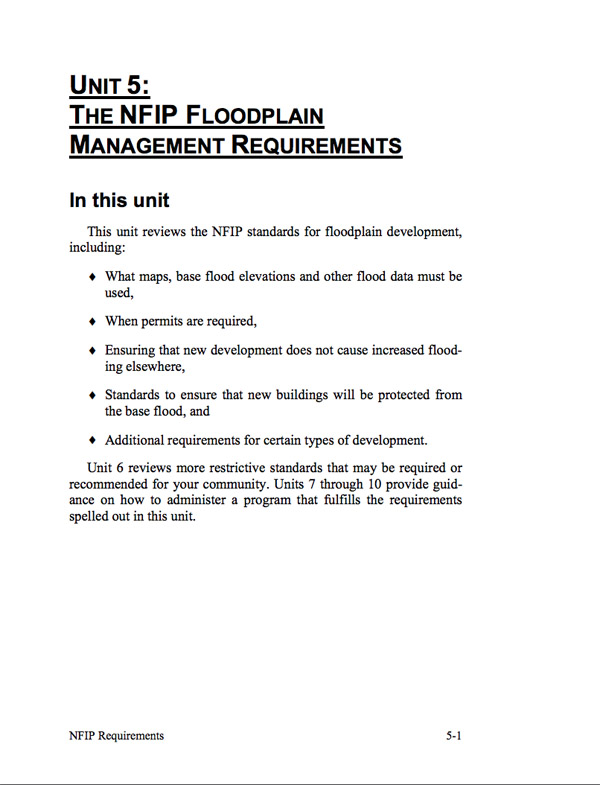 For Zone A, get familiar with the NFIP Floodplain Management Requirements guide, starting on page 5-10. The following content is a summary from that section, but it’s best to feel comfortable with the details in order to keep your community safe. You can always call your Regional Floodplain Manager to discuss the details and get clarity on anything that isn’t making sense. Use them as your team to figure this out. It’s not easy and it’s important to get right because future permits and the physical safety and financial security of your neighbors may be based on the work you do.
For Zone A, get familiar with the NFIP Floodplain Management Requirements guide, starting on page 5-10. The following content is a summary from that section, but it’s best to feel comfortable with the details in order to keep your community safe. You can always call your Regional Floodplain Manager to discuss the details and get clarity on anything that isn’t making sense. Use them as your team to figure this out. It’s not easy and it’s important to get right because future permits and the physical safety and financial security of your neighbors may be based on the work you do.
Get the Base Flood Elevation for All New Development in Zone A
Any new development or substantial improvement within Zone A needs to have a BFE determined as part of the application process. To start, you’re required to look through what already exists. Here are all the possible places you’ll find data that could provide the BFE:
- Check the Flood Insurance Rate Maps (FIRM), Flood Insurance Study and municipal records, and check with your Regional Floodplain Manager regarding records and studies.
- Contact your Regional Floodplain Manager to see if FEMA, US Geological Survey, Army Corps of Engineers, National Resources Conservation Service, or Housing and Urban Development have conducted studies to determine BFE data for the site. The USGS may have also documented high water marks.
- If a body of water forms a boundary between two communities, the community on the other side may have a detailed study. Such base flood data are valid for both sides of a body of water.
- Existing State studies, including VTrans hydraulics studies for any nearby bridge or major culvert might provide BFE.
- Hydro-power dams likely have a study providing BFE for their federal license.
You could use data from any of these studies as long as they:
- reasonably reflect flooding conditions expected during the base flood,
- are not known to be technically incorrect, and
- represent the best data available.
If the BFE Doesn’t Already Exist, Hire Someone to Determine It
If none of the sources above are able to provide the BFE, the next step is likely to require the property owner or developer to commision a study to determine it. This requires hiring a surveyor or engineer and provides information about the channel and local valley cross-sections, hydrology, and hydraulics. Detailed studies typically use modeling programs such as the US Army Corps of Engineers HEC-RAS. The people conducting this study should review FEMA’s document on Managing Floodplain Development in Approximate Zone A Areas.
Permit Documentation and the Importance of Doing This Well
Whichever method you use to determine the BFE, be sure to record on the permit records where the flood elevation came from and any helpful notes about how it was determined. This will help you be consistent with future development in the same area.
We want to stress the importance of developing an accurate determination for the safety of your community and anyone who purchases this building in the future. When Hurricane Harvey swept into Houston, TX in 2017, thousands of homeowners suffered significant damage because their homes were built in reservoirs that were designed to flood. They never knew they lived in a reservoir because local officials who signed the development permits either didn’t do their homework or based their determinations on other permits that omitted that information, as reported by the Texas Tribune, and later in the New York Times. Keep your community safe and help people understand their flood risk with the help of your Regional Floodplain Manager.
Amending Zone A Maps
If you believe the SFHA is wrong, you can work with FEMA to consider amending the map and obtaining a Letter of Map Amendment (LOMA). You’ll need a surveyor or an engineer and you’ll want to start working with the FEMA map team and review Vermont’s guidance on the data for a LOMA in Zone A.

Reflection Questions
- Where are the Zone A flood hazard areas in your town or city?
- What other map resources and other studies are on file in your town office?
- Where are buildings with Letters of Map Amendment (LOMA) or recently constructed bridges that can help determine the BFE?
- What other resources may be available to determine the BFE?


